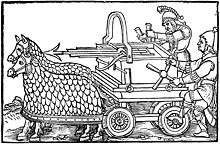Carroballista
.jpg)
Carroballista was an ancient, cart-mounted ballista, a type of mobile field artillery. According to the Roman author Vegetius (Epitoma rei militaris II.25), each legion had 55 carroballistae (one per century) which were arrow/bolt-shooter of the cheiroballistra type. Vegetius tells us that each carroballista was carried by mules and operated by one contubernium (i.e. ten private soldiers commanded by one decanus). Surviving representation of a carroballista are from the bas-reliefs of Trajan's Column (Scene XL and Scenes LXV/LXVI) and the Column of Marcus Aurelius.
Structure
The structure of the carroballista machine is identical to that of the cheiroballistra or manuballista. It seems so that the technical innovations introduced by the adoption of the cheiroballistra by the Roman Army at the end of the 1st century AD made the use of the cart possible. In fact, the light but stout metal spring-frame and the wider space in the frontal part of the machine given by the arched strut conferred a greater manoeuvrability to the whole ballista.
Firing position
.jpg)

According to the Trajan's column representation (Scene XL), the carroballista was manoeuvred by one man mounted on the cart with the ballista and by another man positioned behind the cart and operating probably some sort of winch handle. The presence of the mules in front of the cart suggests that the carroballista could be easily moved through the battle-field whilst shooting bolts. This interpretation is not unanimously accepted by scholars.
It is not certain that the ballistae are actually firing. The whole representation could be simply an image of carts transporting ballistae to their destination nest on the battle-field. But is a matter of fact that the bolts or arrows are here depicted in a ready-to-be-shot position, and this is strange or impossible or even extremely dangerous for the artillery men if the ballistae are simply being transported in this position to be then dismounted and deployed on the battle-field.
In another section of the Trajan's column (Scene LXVI) the simple transportation of the ballista is depicted and now we have no arrows or bolts to be fired ready on the ballista, the ballista is empty, and no artillery man is manoeuvring the machine. An artillery man is pulling the cart near the wheel and this suggests that the whole machine must have been quite a heavy structure.
Structure of the cart

It is sure that the cart was pulled by two mules or horses and that the size was probably that of standard Roman carts, i.e. c. 5 Roman feet (c. 147,85 cm) width (as depicted in the Trajan's Column, Scene XL and Scene LXVI), but the whole design of the cart is uncertain.
There are many hypotheses about the structure of the cart and probably different models of the same machine seem to have been in use at the same time:
- a simple two-wheels standard cart used to transport the ballista to its final emplacement on the field;
- a special two-wheels cart [i.e. carroballista] with a ballista mounted on the cart and with the frontal part positioned towards the mules;
- a special ballista simply mounted on two wheels and without cart (Trajan's Column Scene LXVI) and probably transported with the frontal part positioned rear, like Modern Era cannons, or forward and with a Transport-hook or Transport-hooks at the frontal position (see again Trajan's Column, Scene LXVI).[1]
- a special four-wheels cart with a mounted ballista, as described in the book De Rebus Bellicis.
Many scholars do not have an opinion about this problem, due to scarce evidence, as clearly stated by Alan Wilkins.
Carroballista in Chinese
In the Far East, the carroballista was invented in the Tang Dynasty and was known by the name "spear - carriage crossbow" (crossbow which shot arrows long as spears). Du You mentioned it in Tongdian:
| “ | 作軸轉車,車上定十二石弩弓,以鐵鉤繩連,車行軸轉,引弩弓持滿弦。牙上弩為七衢,中衢大箭一,鏃刃長七寸,廣五寸,箭簳長三尺,圍五寸,以鐵葉為羽;左右各三箭,次小於中箭。其牙一發,諸箭齊起,及七百步。所中城壘,無不摧隕,樓櫓亦顛墜。謂之「車弩」 | ” |
Translated: Made an axle, on cart fixed 12 shi (1600 lb) crossbow, using crampon to link ropes; when cart move, it make crossbow to be stretched. We made 7 intersection on crossbow, middle intersection fixed one large arrow, arrowhead is 7 cun (21 cm) in length and 5 cun (15 cm)in diameter,shaft is 3 chin (90 cm) and 5 cun (15 cm) in perimeter, nock made by iron pieces; on the left and the right, we placed 3 arrow each side, other side placed one arrow. When we shot, arrows could flight to 700 bu (105 m). If it was lose to walls, it will destroyed them. It was called "Carriage crossbow".
Sources
- J. P. Oleson, The Oxford Handbook of Engineering and Technology in the Classical World, Oxford 2006, page 699.
- W. Soedel and V. Foley, The Greek and Roman Ballistae, Scientific American, March 1979 [pp. 150 – 160]
- A. Wilkins, Roman Artillery, Princes Risborough 2003, pages 39–50. Wilkins, teacher of Classics at the University of Cambridge, produced for the first time real scale operating ballistae, among which the famous stone-thrower for BBC and a cheiroballistra.
References
- ↑ About this hypothesis and a proposal of reconstruction of a carroballista of this type, see W. Soedel and V. Foley, Scientific American, March 1979, pp. 150-160.
- ↑ Du You, Tongdian, Military
External links
![]() Media related to Carroballista at Wikimedia Commons
Media related to Carroballista at Wikimedia Commons
